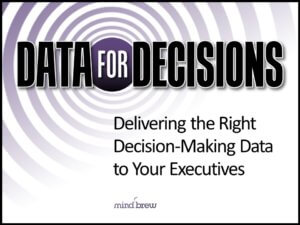Statistician W. Edwards Deming famously said, “In God we trust. All others must bring data.”
As a pricing professional, a big part of your job is to “bring the data.” It’s your role to provide the numbers that will not only guide pricing decisions, but often also guide the company.
The problem is that most executives are not great at drawing conclusions from data. To be a good CEO, you need to excel at seeing the big picture. And very few people who are big-picture thinkers are also excellent at making sense of minute details. If you present them with a column of numbers, they might not immediately understand what it means. Worse yet, they might draw exactly the wrong conclusions from those numbers.
To be clear, this does not mean your executive team is unintelligent or bad at their jobs. Just the opposite, in fact. Most of the very successful people in upper management have learned to deliberately focus on a few things and intentionally not pay attention to things that aren’t part of their jobs. And that includes the data analysis skills that are part of your job.
Unfortunately, that leaves you with a challenge. You need to present data to a group of people who aren’t very good at analyzing data. And this particular group is unlikely to admit that they aren’t good at analyzing data (or to look at you favorably if you suggest they aren’t good at analyzing data).
So how do you solve this dilemma? Here are three tips:
- Work to deliver the data they need—not just what they want. If you ask your decision-makers what data they want, they will likely ask for current statistics that already exist in a table somewhere. But this probably isn’t the most valuable data for them to see. Instead of today’s data, they need to know tomorrow’s data—that is, where the trend lines are headed. Instead of raw numbers, they need an analysis that highlights outliers and potential problems. Yes, you should give them what they ask for, but you should also give them what they really need to see.
- Strive to make your data a no-brainer for others to interpret. Remember that truism about a picture being worth a thousand words. It goes double for data. A good chart or graph with a trend line will make your case much better than any column of numbers ever could. And use color to make things obvious—like red for bad news and green for good news. Also, before you present your data to those in charge, test your presentation by running it past someone else who isn’t a “numbers person.” If it seems too obvious to you, make it a little bit more obvious, and then you’ll have the presentation just about right.
- Go further than just the data—suggest priorities and potential next steps. Your management team probably won’t adopt your suggestions. But that’s okay! By suggesting next steps, you’ll get them debating the next steps, which is a whole lot better than having them debate your data. If they are debating the next steps, it means that they have accepted your data, which was your goal in the first place.
We expand on these points and offer a whole lot of related advice in the webinar on Delivering Data to Decision-Makers. And if this topic interests you, you should also check out The Fundamentals of Effective Pricing Analysis and Using Pricing Analysis to Drive More Growth.
Over time, presenting management with the right data in the right way will build your reputation as someone that they can trust. And become more data-driven will help your organization succeed, while going a long way toward helping you build a successful career.
















